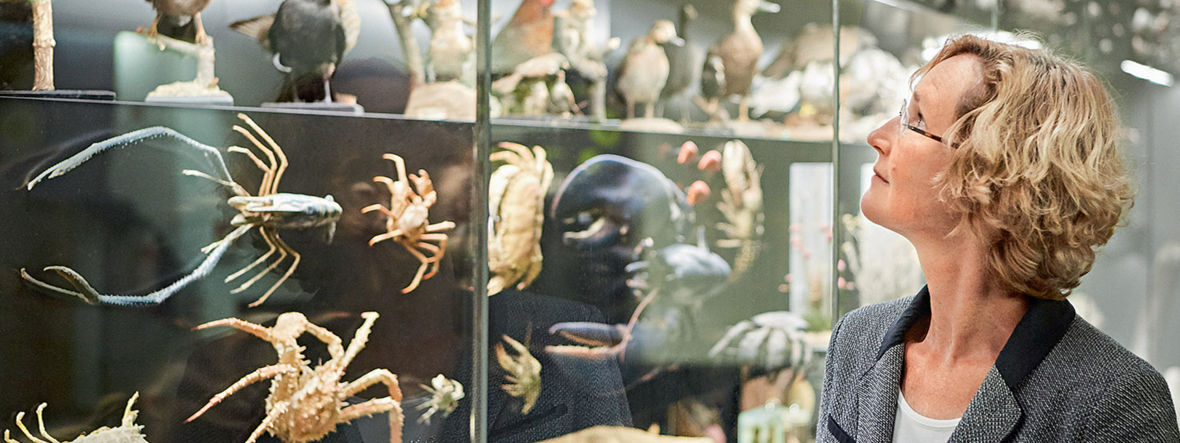Ms. Böhning-Gaese, you recently visited Mount Kilimanjaro. What’s the current level of biodiversity on Africa’s highest mountain and its melting glacier?
Glaciers are not of central importance for biodiversity and human beings. The important thing is the vegetation on the mountain. The landscape there is hot and dry. If no mountain were there, the region would have precipitation only a few times per year. Mount Kilimanjaro generates orographic rain. The trees and bushes, lichens and mosses “milk” the clouds, so to speak - and that’s important for the capture of water. Today 1.4 million people live on the mountain or around it.
How can forests support so many people?
The special thing about Mount Kilimanjaro is the Chagga Home Gardens. Banana trees grow in these tree gardens, with coffee plants growing under them and vegetables flourishing even further down under the coffee plants. The banana leaves are spread out on the ground, thus preventing the soil from drying out or being washed away. They also return nutrients to the soil. Once in a while you’ll see a cow in the Gardens. There are pigs and chickens. Meanwhile, huge rain forest trees have been left to grow. All of these factors are creating one of the most sustainable and biodiversity-rich systems we know of. People can have a healthy and sustainable diet on and around this mountain. This would be a model for many regions of Africa.
In many parts of the world there is only a very slight awareness of climate protection and the conservation of nature. Why is that?
People need to understand that climate change is connected with the loss of biodiversity. They have to know what must be done in order to protect the climate and biodiversity. Almost every measure for protecting the natural environment is also a climate protection measure, but not every climate protection measure serves to promote biodiversity. Just think of the cultivation of bioenergy plants, for instance.
There have been five mass extinctions of species in the history of the earth. Dominant species always perished. Now you’re talking about the sixth mass extinction, and the dominant species is the human being. Can this process still be stopped?
Yes, we are working on the topic of biodiversity with the same kinds of models as in climate research - in other words, future scenarios in which we look at various different futures. As a society and in our political decision-making, we are deciding which scenario we want to pursue. If we continue to behave as we have so far, biodiversity will continue to decrease. But there is also a scenario with which we can avoid disaster.
We’d like to hear more about it.
In order to stabilize biodiversity by 2030 and even increase it by 2050, we need three packages of measures: first, huge protected areas that are well managed and a renaturation of ecosystems; second, sustainable and productive agriculture; and third, a change in consumption, meaning less food waste and a more plant-based kind of nutrition. If all of this is implemented, biodiversity will recover and can even increase.
In 2022 there was a breakthrough at the UN Biodiversity Conference COP15 in Montreal, Canada: The community of states adopted a framework agreement according to which 30 percent of the earth’s surface is to be placed under protection by 2030. Can this plan succeed?
Basically it can. In Germany we’re already near the mark. But we’re very bad at implementing this protection effectively. For example, the Wadden Sea National Park has no parallel anywhere in the world. However, fishing with bottom trawl nets is legally practiced in its core zone. In some countries in the Global South, the challenges are smaller than they are in Germany because they have lower population densities. If Brazil would protect its extensive forests, it could easily reach the 30 percent goal.
In the past we’ve failed to reach many goals. Has the bar been set too high?
If the policymakers don’t set ambitious goals, we’ve already lost the struggle. The next step is to make these goals measurable so that we can demand their attainment. We’ve already become better in this regard: The goals of the Montreal agreement are more frequently quantitative than was previously the case. There is also a bigger consensus among the public and the media that more has to be done. We can only implement legislative changes or a reallocation of subsidies if this public backing exists.

In the area of agriculture, we’re seeing that policymakers quickly revoke restrictions if people only protest loudly enough.
If you have 200 farmers with 200 tractors, that always looks like a lot of resistance. But I believe that the EU Nature Restoration Law, through which we are to reach the 30 percent goal, will be adopted - unlike the pesticide law, for example, which was too narrowly conceived and was not well thought out. But even though farmers protest against one measure or another, we have to keep in mind that organic farmers’ associations, for example, strongly advocate renaturation. Agriculture is an important key: Three quarters of the world’s arable land are used to grow animal feed. If our consumption of animal products were halved, a great deal of arable land would become available.
So, vacant fields for industry?
No, the goal for industry must be the circular economy: reduce, reuse, recycle. This means that biomass is not cultivated and then burned, and that waste materials are utilized very differently. The promotion of bioenergy has given us the wrong incentives: Wonderful meadows were dug up in order to plant corn for producing energy. We have to make very sure that this time we pursue a strategy that doesn’t once again turn out to be counterproductive. If renewable raw materials are introduced into the chemical value chain, that’s different from putting them into a gas tank and then blowing them into the air again after fractions of a second.
How does the economy benefit from more biodiversity?
A current report of the World Economic Forum states that in the next ten years five environmental risks will be among the biggest threats to the economy. Biodiversity and the collapse of the environmental systems have moved upward to third place. First place is occupied by extreme weather events, and in second place are critical changes in the earth system. If you look at it from the negative side, you can put it this way: There is no business on a dead planet. From a positive perspective, companies that invest in biodiversity today are creating market advantages for themselves, because the regulatory agencies will soon demand this anyhow.
Can industrial locations compete with one another fairly? No matter how advantageous green energy may be in the EU, it can’t compete with fracking gas in the USA in terms of pricing.
This is where the policymakers need to act. For example, the European Union is now introducing mandatory reporting by companies. In the future, companies must document the size of their footprint in various environmental dimensions ranging from biodiversity and the protection of ecosystems to the circular economy.
Will that lead to the desired goal? At the moment, chemical production is primarily increasing in China.
Through the supply chain directive, we at least have an instrument that extends into other countries. If Chinese suppliers want to do business in Europe, they have to provide documentation about the conditions under which their products were manufactured. It may take a while for the importance of biodiversity to be recognized in Beijing as well. However, the Chinese population has experienced what happens when a business promotion policy completely ignores environmental issues. It leads to incredible levels of air pollution or dust storms that cause huge problems for cities. China has now enforced very ambitious plans in this regard.
What would you like the economy to do?
Companies are indeed part of the problem, but they’re also part of the solution. The level of ambition is raised higher by means of more stringent reporting requirements. Ultimately, companies should have a positive influence on biodiversity. That would push the business model in the right direction. In the food industry, companies are already emphasizing animal welfare or a strongly plant-based product range - because consumers are demanding these measures.
How long will it take for us to be able to feel, or at least measure, a turnaround?
People who redesign their gardens to be more natural notice the difference in just a few years. The same applies to agriculture. For forests, it can take more time. In Tanzania they are now trying to establish a huge nature conservation area in a parched and partially oversalted savanna. The trees are growing slowly because the region is relatively dry - but people are already seeing the first herds of impalas and zebras. As you can see, change can happen quickly.



